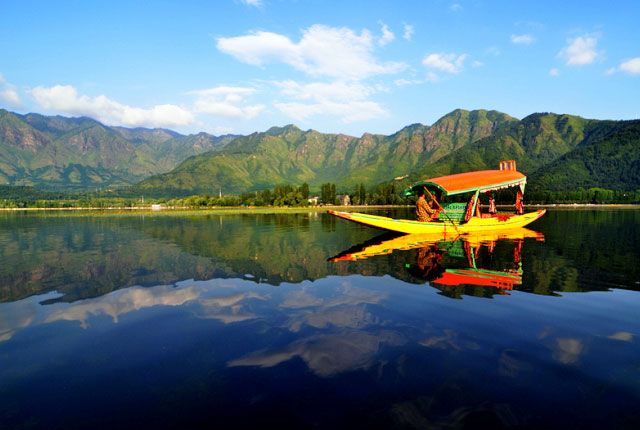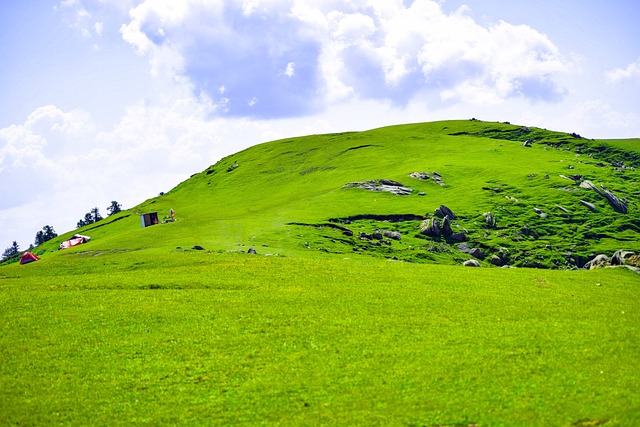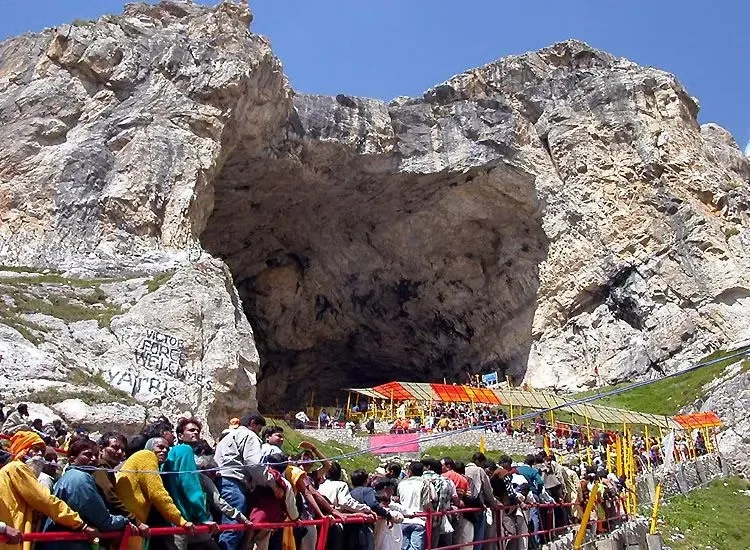
Amarnath Temple : A Complete Guide
Table of Contents
ToggleOverview
Located in the midst of the snow-capped Himalayas of Jammu and Kashmir, the Amarnath Temple is among the most sacred pilgrimage sites for Hindus all over the world. Thousands embark on the sacred yatra every summer, trekking over pristine valleys and snow-laden paths to witness the miraculous work of the natural ice lingam in the Amarnath Cave Temple. This blog delves into every aspect of the Amarnath pilgrimage—from the historical roots and mythological lore to practical tips on registration, routes, accommodation, and safety. Whether you’re a seasoned pilgrim or a first-timer planning your Amarnath trek, this comprehensive guide will ensure you’re fully prepared for an unforgettable spiritual adventure.
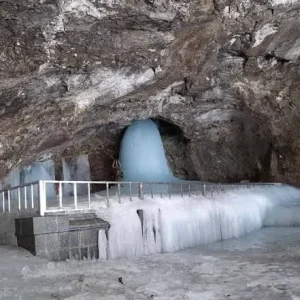
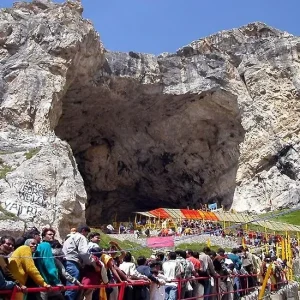
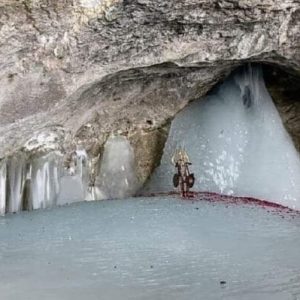
Historical Significance of Amarnath Temple
The history of the Amarnath temple goes back centuries in written records and the first accounts date back as far as the 16th century. Constructed by King Akbar in the 1500s, the temple complex has been shaped and evolved over time by subsequent kings, namely the Dogra kings of Jammu. The Amarnath Cave itself had existed for much longer than the permanent infrastructure was established, with the native tribes of the region such as the Gaddis and Gujjars approaching the location as a natural manifestation of the presence of Lord Shiva. Pilgrim traffic became progressively formalized over the centuries under British and subsequent Indian rule, establishing systematic paths via Pahalgam and Baltal and the modern Amarnath registration system. Currently, the Amarnath Temple is an opulent brocade of religion, history, and Himalayan architecture that has stood the capricious weather of the mountains for centuries.
Mythological Significance
According to Hindu mythology, it is here at the Amarnath Cave Temple that Lord Shiva revealed the eternal secret (Amar Katha) to Goddess Parvati. In order to maintain the religious sanctity of this divine conversation, it is believed that Shiva created an avalanche that sealed the cave from human vision. When Parvati continued to insist on discovering the truth, Shiva withdrew to this distant Himalayan cave, where the immortal secrets were disclosed. The stalagmite formation in the cave is considered to be a physical manifestation of Lord Shiva himself, caught up in a single “ice lingam.” The natural ice lingam grows and dwindles with the phases of the moon, symbolizing the circular processes of creation and destruction in Hindu cosmology. The Amarnath pilgrimage, therefore, is not only a physical pilgrimage but a repetition of this symbolic mythological experience.
Location and Geography
Amarnath Temple is located at an altitude of 3,888 meters (12,756 feet) above mean sea level in Lidder Valley. The cave is located approximately 141 kilometers from Srinagar, between the base camps of Pahalgam and Baltal. The region contains challenging terrain, alpine meadows, and glacial streams. Pilgrims traverse mountain passes of high altitude such as Sheshnag (3,602 meters) and Zoji La (3,042 meters) with constantly shifting scenery—pine forests giving way to rock and snowfields. Climbing and weather conditions of the mountains necessitate careful acclimatization, and hence this guide’s advice on “Amarnath weather” and “altitude sickness prevention” is necessary for a pilgrim’s success.
The Holy Ice Lingam
At the center of the Amarnath pilgrimage is the natural ice lingam that forms in the cave throughout the pilgrimage period (often late June through early August). It is caused by water drops falling from the ceiling of the cave and freezing upon coming in contact with cold cave floors, which create a column of ice. Pilgrims gather before the lingam to offer prayers, flowers and incense. The size of the ice lingam also varies immensely from year to year based on temperature, snowfalls, and rainfalls. The sight of ice lingam within Amarnath Cave Temple is said to be a one-of-its-kind Godly experience, which is usually narrated by pilgrims in the form of an unambiguous communion with Lord Shiva himself.
Amarnath Yatra Routes
Pahalgam Route
The traditional Pahalgam route is the less demanding but longer of the two primary trekking routes. Starting from Pahalgam (2,274 meters), pilgrims go around 43 kilometers in five to six days through picturesque camps of Chandanwari, Sheshnag, and Panjtarni. It is the most popular route chosen by those going for gradual acclimatization and ample time to soak in the pristine Himalayan wilderness. Key attractions include walking over the Sheshnag Lake, walking through the Lidder River, and having vistas of the mountains as panoramic views.
Baltal Route
For the time-pressed pilgrim or the adventure-seeker, Baltal trek is a shorter but steeper trek of approximately 14 kilometers from Baltal Base Camp. Baltal’s route is at 2,743 meters, and the trek involves ascents of boulder-covered ground and ridges. The Baltal trek is also renowned for its “Amarnath helicopter service” that can take you directly from Baltal to Panjtarni, and therefore it is ideal for older or comparatively less-fit pilgrims. Although the trek may be short on time, it has breathtaking views of white peaks and is ideal for the devotees who want to complete the Amarnath pilgrimage within a shorter time frame.
Registration and Permits
For the sake of minimizing pilgrimage traffic and ensuring safety, the Government of Jammu and Kashmir strictly controls an online registration and permission system for the Amarnath Yatra. Pilgrims must register on the official Amarnath Yatra portal and provide identification details, health certificates, and emergency contact numbers. Registration is in May and is by mid-July, or when the pilgrim quota fills up. There is an artificial registration charge, the proceeds of which are used for environmental protection and logistics coordination. On successful online registration, pilgrims are given a permit to be printed at checkpoints along the way. Alternately, for late entrants or those preferring doorstep registration, there are counters at major transit points such as Srinagar Airport and Pahalgam town, though online registration and “Amarnath booking” on official websites are strongly recommended to avoid delays.
Optimum Time to Visit Amarnath
The optimum time to visit Amarnath is from around June 28 to August 15, when the ice lingam is best developed and weather is relatively calm. During early season (late June), the snow is heavy and path is hard, while late season (mid-August) can be subject to rains and heat which could lead to ice lingam melting. Monitoring “Amarnath weather reports” before embarking is crucial. Clear skies and gentle daytime temperatures (10°C to 20°C) are the best conditions for trekking, with the night temperatures plummeting below freezing. Pilgrims need to prepare for the middle-of-July to early-August fortnight when the lingam is established and the chance of closure of routes due to adverse weather is less.
Preparation and Packing Guide
Completion of the Amarnath trek requires meticulous planning and diligent packing:
- Clothing Layers: Bring thermal innerwear, fleece jackets, down jackets, waterproof trekkers’ pants, and windproof outer shells. Layering makes it easier to adjust to varying temperatures.
- Footwear: Waterproof, durable, ankle-high trekking boots are essential to hike on boulders and ice. Two pairs of moisture-wicking socks should be included.
- Backpack Essentials: A 40–50 liter rucksack, rain cover, water bottles or hydration bladder, and quick-dry towels.
- Medical Kit: Include altitude sickness medications (e.g., acetazolamide), painkillers, bandages, antiseptics, and personal medications.
- Trekking Gear: Trekking poles, headlamp with spare batteries, sunglasses that offer UV protection, sunscreen (SPF 50+), and lip balm.
- Miscellaneous: Water bottle that is reusable with purification tablets, energy bar, dry fruits, hand warmers, gloves, woollen cap, and a light sleeping bag rated for sub-zero temperatures.
- Documents: Permit, valid ID (Aadhaar card or passport), medical certificate, and list of emergency contacts.
Accommodation and Facilities
Base camps on both routes have varying degrees of accommodation and facilities:
- Pahalgam Camps: Government-run dormitories and tents at Chandanwari, Sheshnag, and Panjtarni, with cots, blankets, and simple washrooms. There are limited private guesthouses in Pahalgam town that get booked well in advance.
- Baltal Camps: Tented camps at Baltal Base Camp and Panjtarni, run by government agencies and private tour operators. Simple dining halls serving vegetarian food and temporary medical facilities are made available.
- Helicopter Service: Baltal to Srinagar and Pahalgam, and Baltal to Panjtarni. Booking of “Amarnath helicopter tickets” in advance is advised, especially in season.
- Medical Assistance: First-aid posts are stationed at regular intervals along both the routes, having oxygen cylinders and paramedic staff. Medical mobile teams accompany large groups of pilgrims.
Safety and Health Tips
- Acclimatization: Climb gradually and factor in rest days. Signs of acute mountain sickness (AMS) are headache, nausea, and dizziness. Descend at once if severe symptoms are experienced.
- Hydration: Dehydration worsens altitude sickness. Strive for 3–4 liters of fluid daily.
- Nutrition: Eat high-carbohydrate, light meals. Energy bars and dry fruits offer rapid calories.
- Buddy System: Never trek alone. Stick with your team or assigned guide.
- Altitude Medicines: Consult a physician before the trek for prophylactic medicines like acetazolamide.
- Weather Warnings: Monitor local weather conditions. Avoid trekking during heavy snowfall or rain to escape avalanches and landslides.
- Emergency Evacuation: Locate nearest rescue points and locations, such as helipads.
Cultural Awareness and Traditions
Local customs and religious sentiments contribute towards the spiritual environment
- Dress Code: Modest clothes covering shoulders and knees. Men wear kurta-pajama or trousers most of the time; women wear salwar-kameez or trekking pants and long tops.
- Ritual Offerings: Flowers, saffron, holy water, and coconuts can be offered by pilgrims at the lingam. Do not leave plastic waste behind; bring biodegradable material.
- Photography: Only allowed outside the sanctum. Do not click photos within the cave for sanctity reasons.
- Local Hospitality: Local individuals and Gaddi shepherds provide refreshments (maggi noodles, chai, and local bread). Act with courtesy, being respectful of their language conventions and customs.
- Prayer Services: Pilgrims stand in gender-specific lines as per lines before they enter the inner sanctum. Follow instructions laid down by temple authorities and volunteers.
Environmental Conservation
With the pilgrimage traffic, the sensitive Himalayan ecosystem must be conserved:
- Waste Management: Bring reusable backpunch containers, don’t use single-use plastics, and dispose of non-biodegradable waste at collection points.
- Eco-friendly Toilets: Use bio-toilets installed in base camps. Do not defecate in the open or in water bodies.
- Trail Preservation: Take marked trails to preserve alpine cover and prevent soil erosion.
- Awareness Campaigns: Temple authorities and NGOs conduct awareness campaigns on “green Amarnath yatra” ideas. Participate in clean-up initiatives near campsites.
- Community Involvement: Local villagers and volunteer groups maintain trails and waste disposal. Support the effort by donating eco-friendly goods or offering to volunteer time.
Frequently Asked Questions (FAQs)
- What is the Amarnath Yatra registration fee?
The minimal fee varies according to pilgrim category (foreign, domestic, senior citizens). Look at the official website for current charges.
- Can women do the Amarnath Yatra?
Yes. The yatra is open to both genders, though medical clearance is required for all.
- Is the ice lingam sure to be formed every year?
Yes, but its size and shape depend upon weather conditions. Rarely does an unexpected rain put its formation in jeopardy.
- How fit must I be for the trek?
Moderate physical fitness suffices for the Pahalgam route; good endurance and physical fitness are recommended for the more strenuous Baltal route.
- Are porters and ponies available?
Yes. Porters, ponies, and doli services can be rented at designated points. Negotiate reasonable rates and check on service credentials.
- What are the facilities available along the route?
There are minimum medical camps with oxygen facilities. Helicopter evacuation is arranged in the case of serious emergencies.
- Can I hire a guide?
Yes. Registered trekking agencies provide trained guides that take care of route security and timely acclimatization.
Conclusion
Amarnath Temple pilgrimage is not merely a physical trek—it is a journey of faith, endurance, and convergence with the divine. From the initial step you take at Pahalgam or Baltal to the point when you finally reach before the stunning ice lingam, every step of the Amarnath trek is spiritually charged. By adhering to the conventions of “best time to visit Amarnath,” carrying the essential things, acclimatization strategies, and eco-friendly attitude, you have a safe, fruitful, and nature-conscious pilgrimage. Embark on this once-in-a-lifetime experience to experience the enchanting ambiance of the Amarnath Cave Temple and etch memories that will last a lifetime.
How to book Kashmir tour?
Contact a travel agency that specializes in Kashmir tours. You can reach out to the following for assistance:
- Phone:
- +91 7889 655596
- +91 7006 891267
- Email:
Inquire about tour packages, itineraries, and pricing, and confirm your booking for a memorable winter experience!
People Also Ask
What is the best time to undertake the Amarnath Yatra?
The ideal window is late June to mid-August, when the snow has cleared and the naturally formed ice Shivling is fully visible inside the Amarnath cave.
How do I obtain an Amarnath Yatra permit?
Register online via the Shri Amarnathji Shrine Board portal. After completing personal and medical forms, collect the physical permit at designated counters in Jammu, Srinagar, or Anantnag.
What are the two main routes to Amarnath Temple?
- Pahalgam Route – 48 km over 4–5 days with gradual altitude gain.
- Baltal Route – 14 km, steeper but doable in a single day.
Can I book a helicopter to Amarnath Cave?
Yes. Helicopter services operate from Baltal or Pahalgam to Panchtarni, followed by a short trek. Book through official or authorized portals in advance.
What is the approximate cost of an Amarnath Yatra permit?
The permit itself costs around ₹100, with additional charges for porters, ponies, and helicopter rides.
Are there age or gender restrictions for the Amarnath pilgrimage?
The Yatra is open to all genders and ages, subject to medical fitness and valid registration.
How do I prepare for high-altitude conditions?
Spend a night acclimatizing in Srinagar or Pahalgam, train with cardio exercises, stay hydrated, and consult a doctor about taking Diamox (acetazolamide).
Is mobile connectivity available?
Connectivity is intermittent. BSNL and Jio offer partial coverage; satellite phones are used by authorities during emergencies.
What medical facilities are available?
Medical camps at Chandanwari, Sheshnag, Panchtarni, and Baltal offer emergency oxygen, first aid, and altitude sickness medication.
How heavy should my backpack be?
Limit your pack to 10–12 kg. Essentials only: warm clothes, ID, water, snacks, and a basic medical kit.
Can I hire a porter or pony?
Yes—registered ponies and porters are available at base camps. Prices typically range from ₹1,500 to ₹3,000 depending on distance and load.
What should I pack?
- Thermal layers & waterproof clothing
- Trekking boots & gloves
- UV sunglasses & sunblock
- Water bottle & energy bars
- First-aid kit & flashlight
How long is the Baltal trek?
The 14 km trek from Baltal to the cave takes about 6–8 hours, depending on your pace and weather.
Where can I stay before the trek?
Pilgrims often stay in Srinagar, Jammu, or Pahalgam in hotels, guesthouses, or camps before moving to the base camp.
Are vegetarian meals available?
Yes—Langars (free food halls) and local kitchens provide simple vegetarian meals throughout the route.
What is the significance of the ice Shivling?
The ice Shivling forms naturally each year and represents Lord Shiva. It waxes and wanes with the lunar cycle and symbolizes the immortality story (Amar Katha).
Can I complete the Yatra solo?
Solo travel is not recommended due to high-altitude risks. Join a group or go with a registered tour operator.
How do I check trail conditions?
Visit the Shri Amarnathji Shrine Board website for daily updates on weather, trail status, and safety guidelines.
Is there a dress code?
No official dress code, but pilgrims should wear modest, layered, and weather-appropriate clothing.
What emergency services are available?
Helipads, medical teams, and rescue squads operate at critical points such as Panchtarni and Baltal.
Can I combine the Yatra with Vaishno Devi?
Yes. Many pilgrims visit Vaishno Devi in Jammu before or after the Amarnath Yatra by planning accordingly via Katra and Pahalgam.
How can I minimize environmental impact?
Use reusable items, avoid plastic, stick to marked trails, and dispose of waste responsibly at designated zones.
Are photos allowed inside the cave?
No photography is permitted inside the sanctum. However, you may photograph the trail and landscapes while respecting others’ privacy.
What’s the cancellation policy for helicopter bookings?
Refunds or rescheduling are typically allowed for weather-related cancellations—check the policy of your booking portal.
Where can I find trusted Amarnath Yatra packages?
Use the Shri Amarnathji Shrine Board’s list of authorized operators for reliable packages including permits, lodging, and guides.



